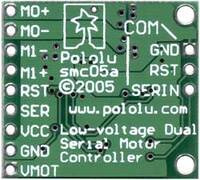Pololu Low-Voltage Dual Serial Motor Controller
Frustrated by those cheap, low-voltage motors that require too much current? Here's the answer: a low-voltage motor controller designed specifically for those toy motors. With all of the convenience of the Pololu dual serial motor controllers and the added ability to deliver 5 amps per motor with no minimum motor voltage, this dual serial motor controller has you covered.
Overview
This low-voltage version of our dual serial motor controller (DSMC) is designed specifically for high-performance, low-voltage toy motors that run on 1.5 - 6 V. Because they run at lower voltages, these motors have higher current requirements, making them difficult to control since most integrated motor drivers are designed either for low-current, low voltage motors (such as those in CD players or cameras) or for higher-voltage motors that run at 6 volts or more. With this latest motor controller, you can consider a whole new range of motors for your next project.
Because of the unique design of the low-voltage motor controller, there is no minimum motor supply voltage, meaning that a motor can be run off of a single cell until it is completely discharged. In a typical application, two to five Ni-Cd or Ni-MH cells can be used throughout their discharge cycle. The motor controller can deliver up to 5 A continuously to each channel, without a heat sink, and like our other dual serial motor controllers, the two output channels can be coupled to deliver up to 10 A to a single load. Since many small Mabuchi motors (such as those used in the Tamiya gearboxes) have stall currents in the 2 - 4 A range, you can drive them to the limits of their performance.
 |
In addition to the motor supply, the controller requires an independent 3.0 - 5.5 V logic supply, which can be higher or lower than the motor supply voltage. This can be useful if you have 3 V motors that you would like to run off of two or three cells but have 5 V logic. If you do have a single supply that satisfies both requirements (which would typically mean 3 or 4 cells), the motor controller can be powered off of a single supply. Each motor has a corresponding pair of LEDs that light up without the motor supply to let you troubleshoot your code without your robot driving away.
The 9-pin module is pin-compatible and code-compatible with our micro dual serial motor controller, making it easy to upgrade your existing robot to higher performance. The low-voltage motor controller shares all of the features of the micro motor controller except for coasting: setting speeds of 0 in forward or reverse will result in braking.
Application notes
Please note that the low-voltage motor controller can become very hot during operation; observe proper precautions around a running unit. A heatsink can improve performance, but it is not required. The motor controller does not feature over-current or over-temperature shutdown. Applying reverse battery polarity or attempting to draw too much current will cause permanent damage to the motor controller.
For high-current applications, make sure to use the thickest and shortest wires possible. Make sure your motors have 0.1 uF capacitors installed across their leads to limit noise and interference with your other electronics. Make sure that your battery can deliver the current that you attempt to draw: typically, you should have at least 1 amp-hour of capacity per 10 amps you draw (which would give you about five minutes of operating time).
Device specifications
- PCB size: 1.0" x 0.9"
- Motor ports: 2
- Speeds: 127 forward and backward, brake
- Max current: two motors 5 A each, one motor 10 A
- Motor voltage: 0 - 7 V
- Logic voltage: 3 - 5.5 V
- PWM frequency: two motors 600 Hz, one motor 750 Hz
- Serial baud rate: 1200 - 19200 (automatically detected)
Note: This product no longer ships with a printed user's manual. The user's manual can be downloaded as a pdf from the resources tab of this product page.
=======================================
Documentation and other information
=======================================
FAQs
How often do I need to send the motor controller a new command?
That is up to your application. The motor controller will keep the motor(s) running at the same setting until you send a new command or reset it.
Can I connect multiple motors to one motor output?
It's certainly possible to connect multiple motors to a single motor output. However, you will need to make sure that the motors do not draw too much current for the motor driver you are using.
When should I use the configuration (set motor numbers) command?
Configuration is intended to be used only when you want to change the motor numbers to which the controller will respond. If you're happy with the default (2 and 3) or the settings you've already chosen, there's no need to re-configure every time. The configuration is stored in non-volatile EEPROM, which means that it is saved even when you reset or turn off your motor controller. The EEPROM can be written thousands of times, but you could use it up if you keep writing new values in a loop.
No recommended products at the moment.
No recommended products at the moment.